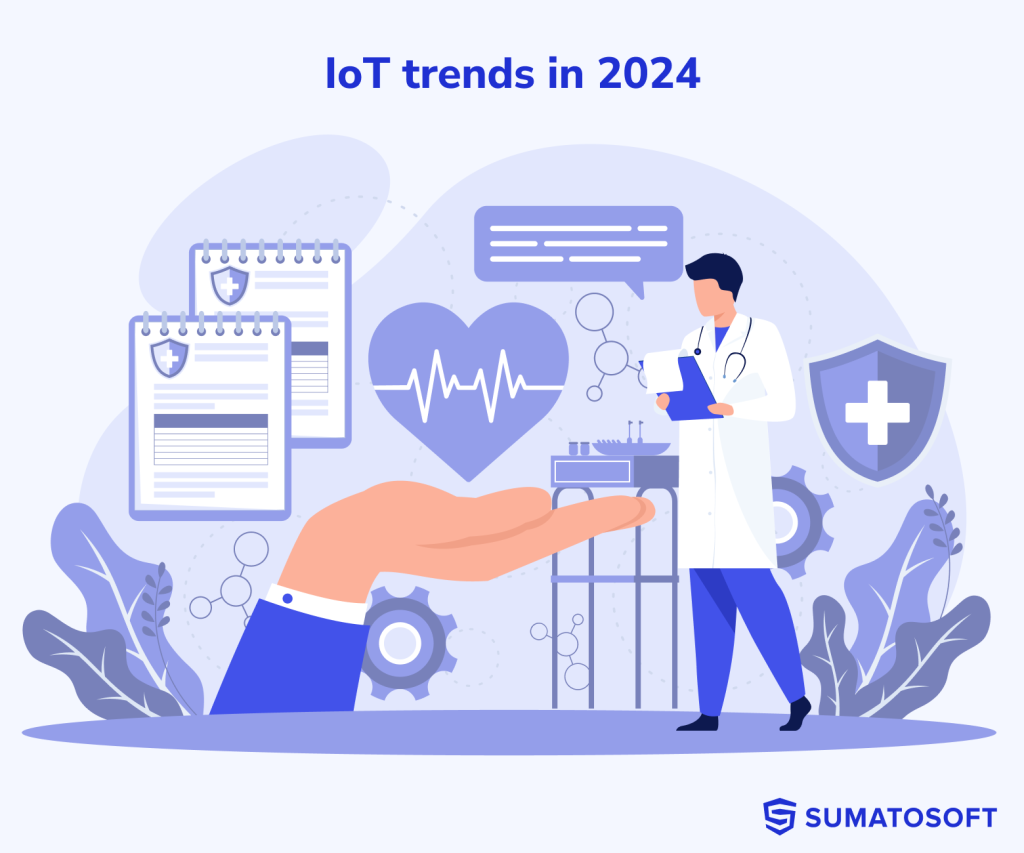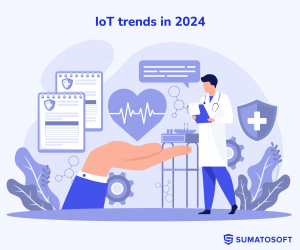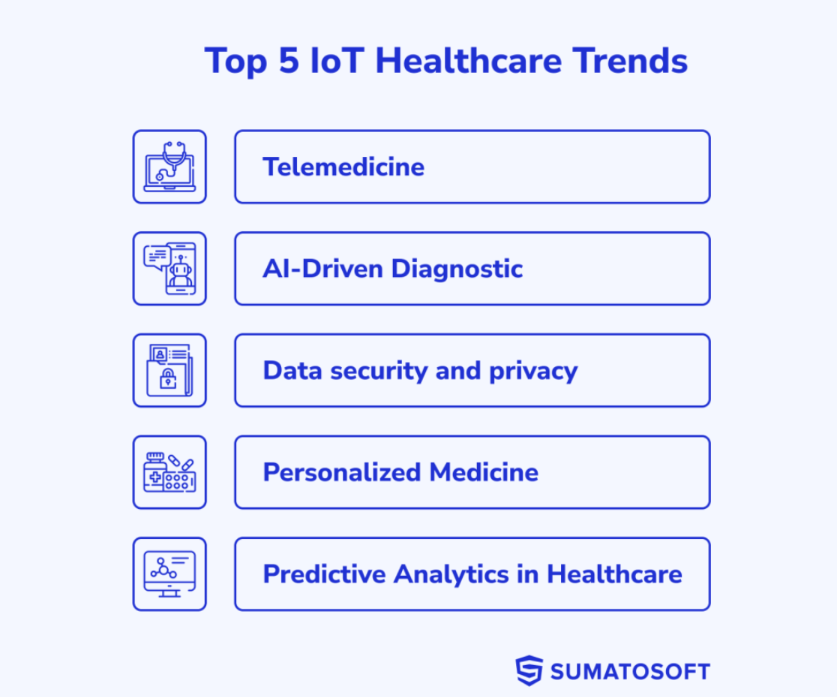Healthcare IoT: Top 5 Trends to Watch in 2025


How does the Internet of Things change our lives?
In different ways: autonomous cars, real-time good monitoring, industry 4.0, smart homes and cities. But, in this article, I want to approach this question from the perspective of our health and discuss healthcare IoT trends. As we step into 2025, the intersection of IoT and healthcare is becoming stronger, fundamentally enhancing the quality and accessibility of healthcare.
This article is the first in a series of articles drawn from the extensive whitepaper we wrote about the IoT role in healthcare. We’ll focus exclusively on the IoT healthcare trends in this article and won’t touch on all other related topics since they will be examined in the following articles.
Top 5 IoT Healthcare Trends in 2025

Trend #1: Telemedicine
Telemedicine, a pivotal IoT healthcare trend for 2025, harnesses technology to deliver medical care remotely.
Imagine a scenario where a patient living in a rural area consults a specialist hundreds of miles away through a video call. The specialist, using data transmitted in real-time from the patient’s wearable health devices, can make informed decisions about their treatment. This is the essence of telemedicine – bringing healthcare to the patient’s doorstep, regardless of location. Telemedicine’s impact is multifaceted:
- it broadens access to healthcare;
- it provides continuous monitoring for people with chronic conditions;
- it fosters patient engagement and empowerment.
Did You Know?
Did you know that healthcare is now at your fingertips with video consultations?
With solutions like Teladoc Health, patients can have face-to-face consultations with doctors and mental health professionals remotely, revolutionizing the way we access medical advice. Not only does Teladoc offer video consultations, but their connected medical devices also enable remote monitoring of chronic conditions, improving patient outcomes and reducing healthcare costs. It’s a new era where quality healthcare is just a click away.
Did you know about the technology that supports seniors in living independently and securely?
Philips Lifeline offers a personal emergency response system, providing seniors with a wearable pendant that detects falls and other emergencies. In an emergency, the system connects to a 24/7 response center, ensuring immediate assistance and peace of mind for both seniors and their families. This innovation epitomizes how technology can enhance safety and independence for the elderly.
Did you know that the reliability of medical devices can be continuously monitored to save lives?
CardiLink specializes in providing an IoT platform service for medical device manufacturers. Their technology plays a crucial role in identifying operational issues in medical devices, contributing significantly to emergency preparedness and patient safety. This is a prime example of how IoT is ensuring the reliability and effectiveness of critical medical equipment.
Trend #2: AI-Driven Diagnostic
AI-driven diagnostics will contribute to healthcare in 2025 by enhancing precision and efficiency in medical analysis. It involves AI systems analyzing medical images, laboratory results, and patient histories to identify patterns and anomalies indicative of specific health conditions. This method significantly enhances the accuracy and efficiency of diagnoses, reducing reliance on manual interpretation and minimizing the chances of human error.
AI in diagnostics is not just an innovation; it’s a paradigm shift in healthcare, offering new levels of accuracy and accessibility in medical diagnostics.
Did You Know?
Did you know that Canon manufactures not only cameras?
Beyond its renowned photography equipment, Canon has made significant advances in medical technology, especially in AI-assisted radiology. Their innovative 3D Landmark Scan technology, utilizing ALD, revolutionizes how medical scans are conducted, enhancing accuracy and efficiency in scan planning and allowing healthcare professionals to concentrate more on patient care.
Did you know that Fujifilm helps to identify pulmonary nodules?
Fujifilm, widely recognized for its photography and imaging products, is also pioneering in medical diagnostics. Their integration of AI in radiology has led to remarkable improvements in the detection and characterization of pulmonary nodules, crucial for early intervention and treatment of lung diseases.
Did you know that a robot could be a surgery assistant?
The realm of surgical procedures is experiencing a paradigm shift with the introduction of AI-driven robotic assistants. Companies like Asensus Surgical and academic institutions like Maastricht University Medical Center are employing these sophisticated robots to enhance the precision and outcomes of surgeries, marking a new era in minimally invasive procedures.
Did you know that AI discovered the drugs that passed clinical trials?
AI is not just a tool for data analysis; it’s now actively involved in drug discovery. For instance, Exscientia’s AI-designed drug molecules have entered human clinical trials, showcasing the potential of AI in accelerating the development of new medications. DeepMind’s AlphaFold, predicting protein structures, further exemplifies AI’s growing influence in pharmaceutical research.
Trend #3: Data security and privacy
Security and privacy isn’t just a IoT healthcare trend; it’s a fundamental concern. And it’s not only older, less tech-savvy companies that are vulnerable.
On October 23, 2023, 23andMe, a company renowned for its genetic testing and personalized health analytics, suffered a significant data breach affecting approximately 6.9 million users. Hackers gained access to the personal information of 5.5 million users who opted into the DNA Relatives feature, which allows sharing of certain data with others.
In 2025, the essence of the trend surrounding data security and privacy in healthcare is not just about protecting against breaches; it’s about safeguarding the very core of individual identity and personal health information. As healthcare systems increasingly adopt digital technologies and store vast amounts of sensitive data, the risk of cyber threats grows exponentially.
This IoT healthcare trend underscores the critical need for robust, sophisticated security measures to protect against unauthorized access, data theft, and breaches that can have far-reaching implications for patient privacy and trust in healthcare systems.
Did You Know?
Did you know that AI-powered platforms can tell everything about the current cyberattack?
Advanced AI systems, like Samurai XDR, use machine learning algorithms to detect and model cyber threats. They specialize in identifying patterns and behaviors indicative of attacks, offering insights not only into where an attack is coming from, but also what’s driving it and, crucially, how to halt it effectively.
Did you know some AI-powered platforms understand your organization’s digital landscape better than security specialists?
Platforms like Darktrace use AI to constantly learn and adapt to an organization’s digital environment. They can identify potential threats and anomalies more quickly and accurately than human specialists, providing an additional layer of security that evolves with the digital ecosystem.
Did you know about Charlotte in cybersecurity?
Charlotte is an AI-driven system employed by CrowdStrike, designed to analyze vast amounts of data for threat detection. Named for its comprehensive understanding of an organization’s digital landscape, Charlotte focuses on endpoint security and delivers real-time responses to sophisticated cyber-attacks, safeguarding the organization’s data more effectively than traditional methods.
Trend #4: Personalized Medicine
Personalized medicine in 2025 is a holistic healthcare approach that tailors treatment and prevention strategies to individual patient profiles. Personalized medicine is based on the usage of sensitive information about patients’ genetic makeup, environmental exposures, lifestyle choices, and biological markers.
Personalized medicine enables healthcare providers to develop more effective and targeted treatment plans, consider potential risks unique to each individual, and offer preventive strategies that are more likely to succeed.
In practice, personalized medicine might involve genetic testing to guide cancer treatment, analyzing lifestyle factors to prevent chronic diseases, or considering environmental influences to manage allergies. It also includes leveraging data from wearable health devices for real-time health monitoring and management. By viewing the full spectrum of factors influencing health, personalized medicine aims to optimize patient care and enhance health outcomes.
Did You Know?
Did you know that logical Artificial Intelligence, devoid of emotions, is caring for people’s mental health?
Platforms like Youper, Wysa, and Kintsugi, leveraging AI, offer personalized mental health support, illustrating how emotionless AI can effectively address emotional human needs.
Did you know that oncology treatments are now even more personalized for every patient?
IBM Watson Health uses AI to analyze medical data, providing highly personalized treatment recommendations in oncology, demonstrating a new era of individualized cancer care.
Did you know about the advancements made by PathAI in personalized diagnostics?
PathAI is revolutionizing the field with AI-driven pathology, enhancing the precision of disease diagnosis and offering tailored insights for individualized treatment plans.
Trend #5: Predictive Analytics in Healthcare
The most evident implementation here is predictive analytics for preventive care. However, the IoT healthcare trend in predictive analytics extends beyond it. It encompasses a broader application, impacting hospital operations, resource management, and overall healthcare system efficiency.
This trend leverages advanced AI and ML algorithms to analyze patterns in healthcare data, enabling healthcare facilities to anticipate and effectively respond to various operational challenges. For example:
- Predictive analytics plays a crucial role in optimizing hospital operations. From predicting patient inflow in emergency departments to anticipating hospital readmission rates, this technology allows healthcare facilities to allocate resources more efficiently and prepare for potential surges in patient numbers.
- Predictive analytics contributes to smoother hospital operations by predicting patient flow and staffing needs. It reduces wait times, improves patient satisfaction, and helps minimize unnecessary costs associated with overstaffing or underutilization of resources.
- Predictive analytics is also transforming administrative aspects of healthcare. AI-driven tools can automate routine tasks like scheduling and billing, reducing errors and freeing up healthcare professionals to focus more on patient care.
Did You Know?
Did you know that AI is optimizing patient flow in hospitals?
Qventus offers an AI-based platform targeting patient flow optimization, including in emergency departments. It uses AI/ML models along with best-practice operational processes to ensure efficient patient management and hospital operations.
Did you know about Philips’ solution for managing patient flow across hospital networks?
The Philips Patient Flow Coordinator Solution integrates predictive analytics for effective decision-making and patient allocation. This system can direct incoming patients to the most appropriate hospital with available beds, enhancing the efficiency of patient care.
Did you know that AI can manage patient beds and predict patient outcomes in emergency departments?
The Amiens Picardy University Hospital in France developed a project called “Prediction of the Patient Pathway in the Emergency Department” (3P-U). This AI-driven initiative enhances emergency department efficiency by predicting patient pathways and managing bed availability, showcasing the impact of AI on critical healthcare operations.
Did you know Cerner Corporation is using AI to prevent hospital readmissions?
The Cerner Corporation developed AI and predictive analytics tools that are applied in various healthcare settings, not only to predict patient deterioration but also to optimize staffing and reduce readmission rates, highlighting the multifaceted benefits of predictive analytics in healthcare.
SumatoSoft: A Leading IoT Software Development Provider
SumatoSoft has been building IoT solutions since 2012, delivering custom enterprise software and developing MVPs to startups gain a competitive advantage and improve their efficiency, effectiveness, and profit through business digitalization.
SumatoSoft offers industry-focused IoT solutions for healthcare, retail, manufacturing, smart homes & cities, and automotive domains. Speaking about healthcare, we developed solution for 24/7 glucose monitoring, a mobile application for personalized wellness programs, a medical transportation platform that operates in 26 states of the US, and more.
Every solution SumatoSoft builds comes with excellent security and scalability for future changes in terms of new features, fleet expansion, new users, and increased workload.
SumatoSoft IoT services include:
- all-around IoT applications;
- connectivity management;
- device management;
- data visualization;
- IoT data analytics;
- IoT consulting.
The SumatoSoft team has built 250 custom software solutions for 27 countries for 11 industries. After more than 12 years on the market, the company became a reliable technical partner to its Clients, demonstrating a 98% Client satisfaction rate with the quality of services they provide.
Contact us to get a free quote for your project.
Conclusion
As we wrap up our exploration of IoT healthcare trends in 2025, it’s clear that the intersection of technology and healthcare is more vibrant and vital than ever. From the personalized touch of AI-driven diagnostics and mental health apps to the operational efficiency brought by predictive analytics in hospital settings, these trends are not just shaping the future of healthcare—they’re redefining it.
The advancements in telemedicine, AI in diagnostics, data security, and predictive analytics underscore a shift towards a more accessible, efficient, and patient-centric healthcare system. Personalized medicine, particularly, stands out as a beacon of hope for tailored treatments and improved patient outcomes.
As we look ahead, the continued integration of IoT in healthcare promises to break new ground, offering innovative solutions to age-old challenges. It’s an exciting time in healthcare, one filled with potential and promise, driven by technology that’s not just smart, but also increasingly empathetic to human needs.
Stay tuned for more insights as we navigate the ever-evolving landscape of IoT in healthcare.
Let’s start
If you have any questions, email us info@sumatosoft.com




